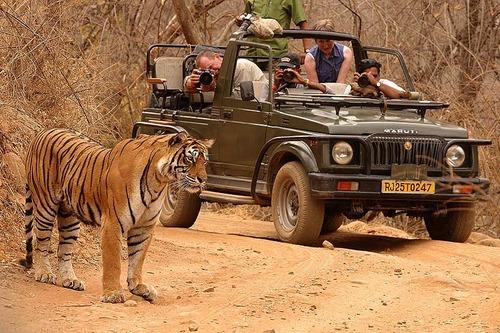Il Rajasthan è un posto nella lista dei desideri di quasi tutti. Riot che invoca i colori, battaglie fortissime, dune di sabbia mozzafiato, orgoglio e onore un po ‘arroganti. Il Rajasthan è un vero stato reale con tutti i mezzi. Il suo cibo ricco, i bei locali e i siti storici sono deliziose attrazioni. Non solo per la sua bellezza e il suo patrimonio proibitivo, lo stato è anche noto per le cose eccitanti da fare. Di molte cose da fare in Rajasthan, qui ci sono esperienze che ti faranno sentire fantastico per il tuo viaggio in Rajasthan.
Fai un safari con la fauna selvatica del Rajasthan –
Il Rajasthan ospita alcuni dei migliori santuari della fauna selvatica e degli uccelli in India. I più popolari sono il Parco Nazionale di Ranthambore, la Riserva delle Tigri di Sariska, il Parco Nazionale di Keoladeo e il Santuario degli uccelli di Bharatpur. Tigri, elefanti, cinghiali, orsi, diverse specie di uccelli e vari altri abitanti del selvaggio vi accolgono in questi santuari della fauna selvatica.
Prendi l’Hot-Air Balloon Ride –
Una delle attività più stimolanti del Rajasthan, le mongolfiere sono un successo sicuro tra viaggiatori e turisti. Salendo in alto nel cielo, si arriva a testimoniare i dettagli delle strutture del patrimonio e ampie estese green. L’esperienza è meravigliosa e ti dà un’idea di questa terra regale. In questo momento, ci sono tre città in Rajasthan dove puoi goderti le mongolfiere: Pushkar, Jaipur e Ranthambore. Fai la tua scelta del paesaggio e parti per navigare nel cielo.

Stare a Deserto Campo : Senti il brivido –
Un fantastico sito glamping, il Rajasthan è famoso per il suo campeggio nel deserto. Il cielo stellato, le vivaci danze popolari, i colorati spettacoli di burattini, i deliziosi pasti autentici e le comode lenzuola sono esperienze che rendono il campeggio in Rajasthan una tale rabbia. Questa straordinaria esperienza di campeggio nel deserto è davvero una delle migliori cose da fare nel Rajasthan durante gli inverni.
Cenare a Chokhi Dhani –
Uno dei migliori posti da visitare nel Rajasthan, Chokhi Dhani non ha bisogno di presentazioni. Un nome sinonimo di ospitalità regale, Chokhi Dhani si rivolge a viaggiatori avidi e amanti della buona cucina per molti anni. Chokhi Dhani serve autentica cucina del Rajasthan con un tocco di calda ospitalità. Anche se non ti piace molto il cibo del Rajasthan, sarai pavimentato dal servizio e dall’arredamento. Le esibizioni culturali e le danze popolari colorate sono a dir poco avvincenti.
Go Trekking At Hills –
Il trekking nel Rajasthan può essere duro e faticoso, visto il caldo clima estivo. Ma nella stagione giusta e in una giornata ventosa, può essere un’esperienza fantastica. La rigogliosa vegetazione di Alwar e la densità del patrimonio del Monte Abu sono i percorsi preferiti dagli amanti dell’avventura. Mentre questi trekking vanno da facili a moderati, la bellezza ultraterrena e il clima salubre attirano non solo i cercatori di avventura ma anche gli amanti della natura. Si arriva a individuare uccelli colorati e interagire con gli abitanti dei villaggi locali.
Camel Breeding Farm In Bikaner –
Una delle cose più insolite e interessanti da fare in Rajasthan è fare amicizia con i cammelli. Visita la Camel Breeding Farm a Bikaner, e prova a giocare e giocare con i cammelli. Soprattutto se viaggi con bambini, incluso un viaggio qui potrebbe essere il momento clou della tua vacanza in Rajasthan.

